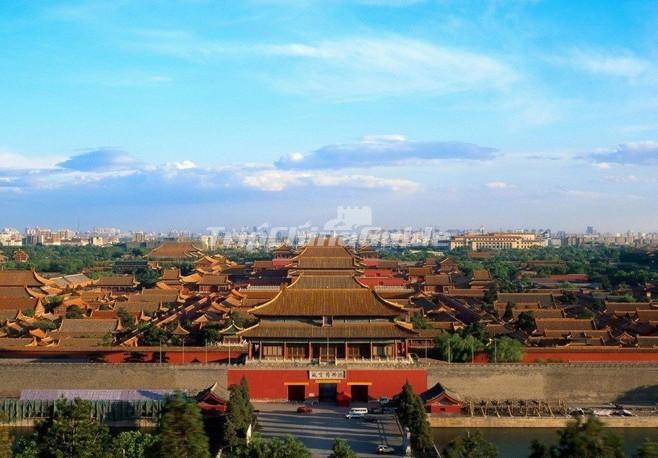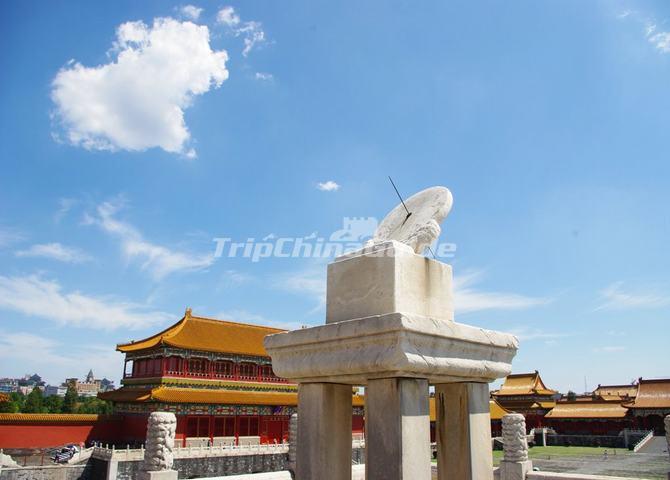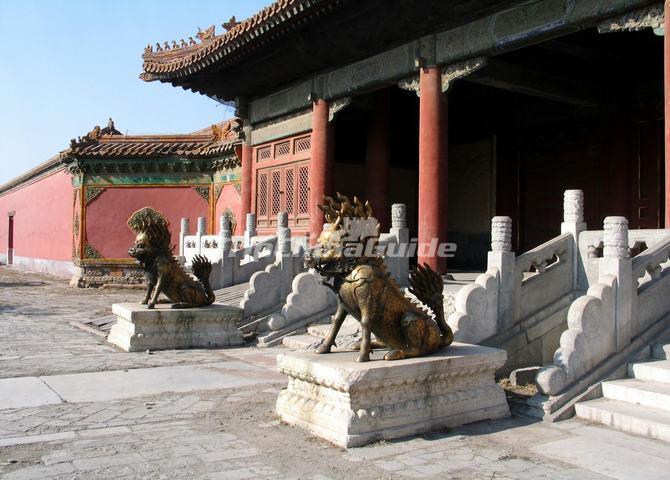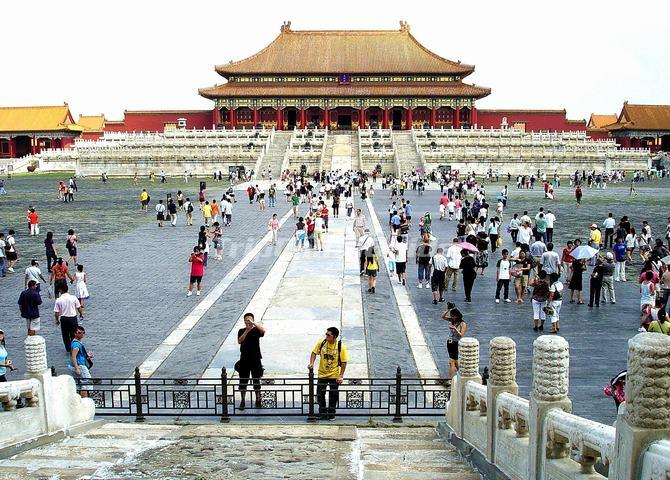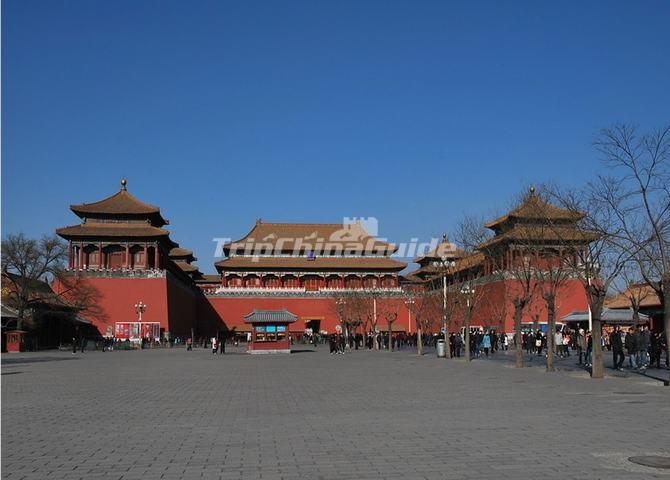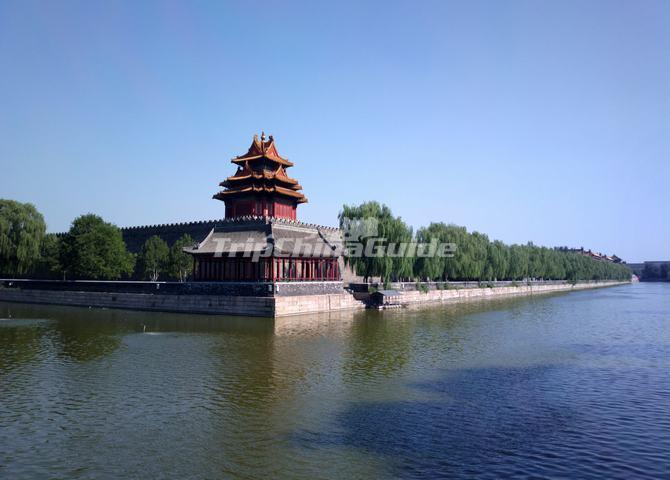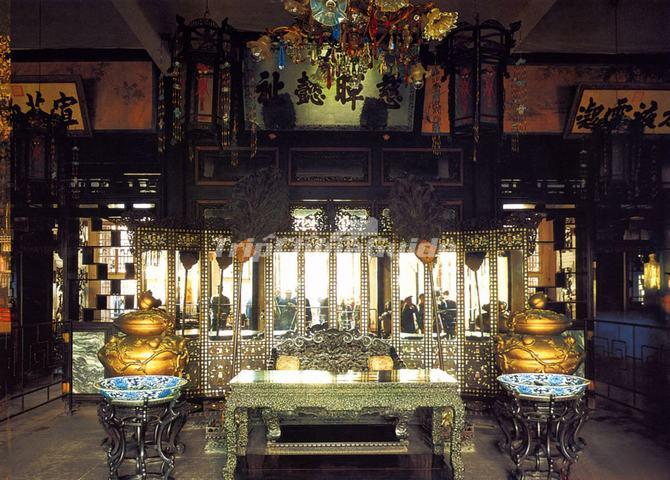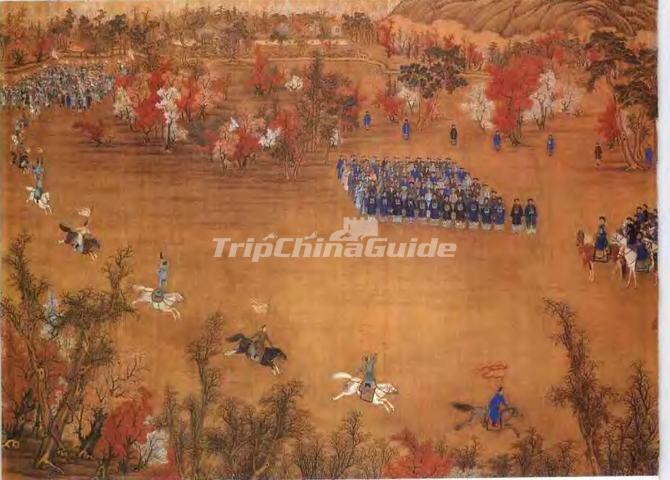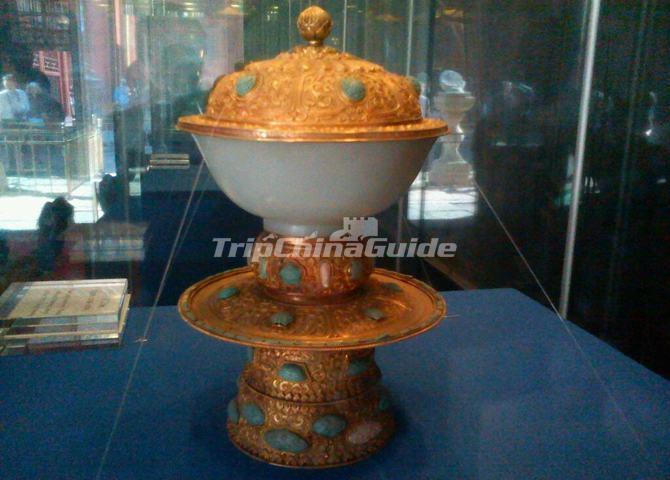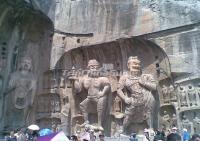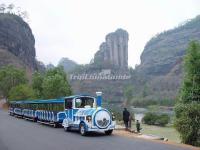Interesting Forbidden City Facts
Enjoy our range of fun Facts on Forbidden City for tourists and kids. Learn who it was built for, what the name means, how long it took to build, historical evolution, buildings, what it is made from, where it is located and much more.
Lying at the center of Beijing, the Forbidden City, also called Gu Gong, in Chinese, was the imperial palace during the Ming and Qing dynasties. Now known as the Palace Museum, it is to the north of Tiananmen Square. Rectangular in shape, it is the world‘s largest palace complex and covers 74 hectares. Surrounded by a six meter deep moat and a ten meter high wall are 9,999 buildings. The wall has a gate on each side. Opposite the Tiananmen Gate, to the north is the Gate of Devine Might (Shenwumen), which faces Jingshan Park. The distance between these two gates is 960 meters, while the distance between the gates in the east and west walls is 750 meters. There are unique and delicately structured towers on each of the four corners of the curtain wall. These afford views over both the palace and the city outside. The Forbidden City is divided into two parts. The southern section or the Outer Court was where the emperor exercised his supreme power over the nation. The northern section or the Inner Court was where he lived with his royal family.
Until 1924 when the last emperor of China was driven from the Inner Court, fourteen emperors of the Ming dynasty and ten emperors of the Qing dynasty had reigned here. Having been the imperial palace for some five centuries, it houses numerous rare treasures and curiosities. Listed by UNESCO as a World Cultural Heritage Site in 1987, the Palace Museum is now one of the most popular tourist attractions worldwide.
Construction of the palace complex began in 1407, the 5th year of the Yongle reign of the third emperor of the Ming dynasty. It was completed fourteen years later in 1420. It was said that a million of workers including one hundred thousand artisans were driven into the long-term hard labor. Stone needed was quarried from Fangshan, a suburb of Beijing. It was said a well was dug every fifty meters along the road in order to pour water onto the road in winter to slide huge stones on ice into the city. Huge amounts of timber and other materials were freighted from faraway provinces. Ancient Chinese people displayed their very considerable skills in building the Forbidden City. Take the grand red city wall for example.,it has an 8.6 meters wide base reducing to 6.66 meters wide at the top. The angular shape of the wall totally frustrates attempts to climb it. The bricks were made from white lime and glutinous rice while the cement is made from glutinous rice and egg whites. These incredible materials make the wall extraordinarily strong.
Since yellow is the symbol of the royal family, it is the dominant color in the Forbidden City. Roofs are built with yellow glazed tiles; decorations in the palace are painted yellow; even the bricks on the ground are made yellow by a special process. However, there is one exception. Wenyuange, the royal library, has a black roof. The reason is that it was believed black represented water then and could extinguish fire.
Nowadays, the Forbidden City, or the Palace Museum is open to tourists from home and abroad. Splendid painted decoration on these royal architectural wonders, the grand and deluxe halls, with their surprisingly magnificent treasures will certainly satisfy "modern civilians".
About Its Name
The common English name, "the Forbidden City", is a translation of the Chinese name Zijin Cheng. Another English name of similar origin is "Forbidden Palace".
The name "Zijin Cheng" is a name with significance on many levels. Zi, or "Purple", refers to the North Star, which in ancient China was called the Ziwei Star, and in traditional Chinese astrology was the heavenly abode of the Celestial Emperor. The surrounding celestial region, the Ziwei Enclosure was the realm of the Celestial Emperor and his family. The Forbidden City, as the residence of the terrestrial emperor, was its earthly counterpart. Jin, or "Forbidden", referred to the fact that no one could enter or leave the palace without the emperor's permission. Cheng means a walled city.
Today, the site is most commonly known in Chinese as Gùgōng, which means the "Former Palace”. The museum which is based in these buildings is known as the "Palace Museum".
Historical Evolution of the Forbidden City
1406
The site of the Forbidden City was situated on the Imperial City during the Mongol Yuan Dynasty. Upon the establishment of the Ming Dynasty, the Emperor Hongwu moved the capital from Beijing in the north to Nanjing in the south, and ordered that the Yuan palaces be burnt down. When his son Zhu Di became the Emperor Yongle, he moved the capital back to Beijing, and construction began in 1406 of what would become the Forbidden City.
1420
The all buildings of the Forbidden City were completed.
1421
The three front halls (Hall of Supreme Harmony, Hall of Central Harmony, and Hall of Preserving Harmony) went up in flames.
1441
Reconstruction of the three front halls and the Palace of Heavenly Purity
1557
The big fire demolished the three front halls (Hall of Supreme Harmony, Hall of Central Harmony, Hall of Preserving Harmony), Entrusted by Heaven Gate (Fengtian Men), Wenwu Building and the Meridian Gate (Wu Men). These buildings were not completed until 1561.
1597
Another big fire demolished the three front halls (Hall of Supreme Harmony, Hall of Central Harmony, Hall of Preserving Harmony) and the three back palaces (Palace of Heavenly Purity, Hall of Union, Palace of Earthly Tranquility). The reconstruction was completed till 1627.
1644
The rebels of Li Zi Cheng captured Beijing and the Ming Dyansty collapsed. The rebels set a fire in the Forbidden City when they retreated from the occupied city. Hall of Martial Valor, Jianji Hall, Yinghua Hall and Nanxun Hall, the four watchtowers and the Gate of Imperial Supremacy are the only buildings to survive the fire. The Qing Dynasty's emperor, Tong Zhi moved the capitale from Shenyang to Beijing, and he began to spend 14 years to rebuild the destroyed architecture.
1683
Emperor Kangxi began to rebuild the rest of the destroyed buildings.
1695
The reconstruction of all the destroyed buildings was completed.
1735
Qianlong acceded to the throne. In his 60 years reign, he made a large-scale construction and reconstruction of the Forbidden City.
1813
Linqing, a follower of the Heaven Reason Society (Tianli "Heavenly Order" Sect) attacked the Forbidden City with a large rebel.
1900
The Allied Forces of Eight Powers (The Eight-Nation Alliance) captured Beijing and held a military parade in the Forbidden City.
1911
The Wuchang Uprising of October 10, 1911 started the Xinhai Revolution, which led to the collapse of the Qing Dynasty and the establishment of the Republic of China (ROC). But the emperor of the Qing Dynasty was allowed to live in the Forbbiden City according to a privilege agreement between the Qing Dynasty and the the Republic of China.
1923
Jianfu Palace met a fire.
1924
Feng Yu Xiang launched "Beijing Coup", Pu Yi, the last Qing Dynasty emperor was expelled from the Forbidden City.
1925
The Palace Museum was establishment based on the Forbidden City.
1933
The Palace Museum was moved to south China to escape the Japanese invasion, burn, kill and pillage.
1948
Most of the cultural relics (that moved to south China in 1933) were carried to Taiwan by Kuomintang (nationalist party).
1941
In January, with the stabilization of Beijing, the Palace Museum was repened to the public.
1961
Palace Museum was designated as the first batch of the national key cultural relics protection units by the State Council of China.
1987
The Forbidden City (Palace Museum) was listed as a World Cultural Heritage site by the United Nations Educational, Scientific and Cultural Organization (UNESCO) in 1987.
2002
The Forbidden City began to make a 19-year overhaul.
Layout
The Forbidden City is a rectangle, measuring 961 meters from north to south and 753 meters from east to west. It consists of 980 surviving buildings with 8,886 bays of rooms; however this figure may not include various antechambers. Another common figure points to 9,999 rooms including antechambers; although this number is frequently cited, it is likely an oral tradition, and it is not supported by survey evidence. The Forbidden City was designed to be the centre of the ancient, walled city of Beijing. It is enclosed in a larger, walled area called the Imperial City. The Imperial City is, in turn, enclosed by the Inner City; to its south lays the Outer City.
The Forbidden City remains important in the civic scheme of Beijing. The central north-south axis remains the central axis of Beijing. This axis extends to the south through Tiananmen gate to Tiananmen Square, the ceremonial centre of the People's Republic of China, and on to Yongdingmen. To the north, it extends through Jingshan Hill to the Bell and Drum Towers. This axis is not exactly aligned north-south, but is tilted by slightly more than two degrees. Researchers now believe that the axis was designed in the Yuan Dynasty to be aligned with Xanadu, the other capital of their empire.
Some Famous Architecture
◎Area for Grand Audience and Ceremony
Gate of Supreme Harmony (Taihe men)
Hall of Supreme Harmony (Taihe dian)
Hall of Central Harmony (Zhonghe dian)
Pavilion of Spreading Righteousness (Hongyi ge)
Gate of Glorious Harmony (Xihe men)
Belvedere of Embodying Benevolence (Tiren ge)
Gate of Blending Harmony (Xiehe men)
Hall of Martial Valor (Wuying dian)
Hall of Preserving Harmony (Baohe dian)
Hall for Cultivating Virtues (Yude tang)
◎Palace Area for Retired Emperor
Belvedere of Pleasant Sounds (Changyin ge)
Bower of the Ancient Catalpa (Guhua xuan)
Hall of Spiritual Cultivation (Yangxing dian)
Hall of Imperial Supremacy (Huangji dian)
Nine-dragon Screen (Jiulong bi)
Palace of Tranquil Longevity (Ningshou gong)
Hall of Joyful Longevity (Leshou tang)
Gate of Imperial Supremacy (Huangji men)
Gate of Conferring Blessings (Xiqing men)
Gate of Tranquil Longevity (Ningshou men)
Pavilion of the Purification Ceremony (Xishang ting)
Bower of Well-nourished Harmony (Yihe xuan)
Hall for Viewing Opera (Yueshi lou)
Well of Concubine Zhen (Zhenfei jing)
◎Area of Gardens and Temples
Pavilion of One Thousand Autumns (Qianqiu ting)
Pavilion of Auspicious Clarity (Chengrui ting)
Pavilion of Floating Jade (Fubi ting)
Hall for Ancestral Worship (Fengxian dian)
Gate of Heaven's Primacy (Tianyi men)
Hall of Imperial Peace (Qin'an dian)
Bower of Crimson Snow (Jiangxue xuan)
Lodge of Spiritual Cultivation (Yangxing zhai)
Shrine to The Four Deities (Sishen ci)
Pavilion of Myriad Springtimes (Wanchun ting)
Hall of Spreading Grace (Chizao tang)
Mountain of Accumulated Elegance (Duixiu shan)
Imperial Prospect Pavilion (Yujing ting
Belvedere of Prolonging Splendor (Yanhui ge)
Gate of Loyal Obedience (Shunzhen men)
Studio of Establishing Teachings (Weiyu zhai)
◎Area of Wall, Moat, and Guard
Meridian Gate (Wu men)
Gate of Divine Prowess (Shenwu men)
East Prosperity Gate (Donghua men)
West Prosperity Gate (Xihua men)
Moat
◎Imperial Residential Area
Palace of Celestial Favour (Chengqian gong)
Palace of Great Benvolence (Jingren gong)
Gate of Thriving Imperial Clan (Longzong men)
Gate of Heavely Purity (Qianqing men)
Palace of Heavenly Purity (Qianqing gong)
Palace of Eternal Spring (Changchun gong)
Hall of Union (Jiaotai dian)
Palace of Earthly Tranquility (Kunning gong)
Gate of Good Fortune (Jingyun men)
Hall of Mental Cultivation (Yangxin dian)
Hall for Abstinence (Zhai gong)
Palace of Prolonging Happiness (Yanxi gong)
Palace of Eternal Harmony (Yonghe gong)
Palace of Accumulated Purity (Zhongcui gong)
Palace of Great Brilliance (Jingyang gong
Gate of Earthly Tranquility (Kunning men)
Palace of Eternal Longevity (Yongshou gong)
Hall of the Supreme Principle (Taiji dian)
Palace of Earthly Honor (Yikun gong)
Hall of Harmonious Conduct (Tihe dian)
Hall of Manifest Origin (Tiyuan dian)
Palace of Gathered Elegance (Chuxiu gong)
Bower of Enchanting Scenery (Lijing xuan)
Palace of Universal Happiness (Xianfu gong)
Hall of Alignment with the Dao (Tongdao tang)
Rear Palace of the Hall of Mental Cultivation (Yangxin dian)
◎Palace Area for Crown Prince
Hall of Literary Brilliance (Wenhua dian)
Pavilion of Literary Profundity (Wenyuan ge)
Walls and Gates
The Forbidden City is surrounded by a 7.9 meters (26 ft) high city wall[11] and a 6 meters (20 ft) deep by 52 meters (171 ft) wide moat. The walls are 8.62 meters (28.3 ft) wide at the base, tapering to 6.66 meters (21.9 ft) at the top. These walls served as both defensive walls and retaining walls for the palace. They were constructed with a rammed earth core, and surfaced with three layers of specially baked bricks on both sides, with the interstices filled with mortar.
At the four corners of the wall sit towers (E) with intricate roofs boasting 72 ridges, reproducing the Pavilion of Prince Teng and the Yellow Crane Pavilion as they appeared in Song Dynasty paintings. These towers are the most visible parts of the palace to commoners outside the walls, and much folklore is attached to them. According to one legend, artisans could not put a corner tower back together after it was dismantled for renovations in the early Qing Dynasty, and it was only rebuilt after the intervention of carpenter-immortal Lu Ban.
The wall is pierced by a gate on each side. At the southern end is the main Meridian Gate (A). To the north is the Gate of Divine Might (B), which faces Jingshan Park. The east and west gates are called the "East Glorious Gate" (D) and "West Glorious Gate" (C). All gates in the Forbidden City are decorated with a nine-by-nine array of golden door nails, except for the East Glorious Gate, which has only eight rows.
The Meridian Gate
The Meridian Gate has two protruding wings forming three sides of a square (Wumen, or Meridian Gate, Square) before it.[39] The gate has five gateways. The central gateway is part of the Imperial Way, a stone flagged path that forms the central axis of the Forbidden City and the ancient city of Beijing itself, and leads all the way from the Gate of China in the south to Jingshan in the north. Only the Emperor may walk or ride on the Imperial Way, except for the Empress on the occasion of her wedding, and successful students after the Imperial Examination.
Outer Court
Traditionally, the Forbidden City is divided into two parts. The Outer Court (or Front Court) includes the southern sections, and was used for ceremonial purposes. The Inner Court 0 or Back Palace includes the northern sections, and was the residence of the Emperor and his family, and was used for day-to-day affairs of state. Generally, the Forbidden City has three vertical axes. The most important buildings are situated on the central north-south axis.
Entering from the Meridian Gate, one encounters a large square, pierced by the meandering Inner Golden Water River, which is crossed by five bridges. Beyond the square stands the Gate of Supreme Harmony. Behind that is the Hall of Supreme Harmony Square. A three-tiered white marble terrace rises from this square. Three halls stand on top of this terrace, the focus of the palace complex. From the south, these are the Hall of Supreme Harmony, the Hall of Central Harmony, and the Hall of Preserving Harmony.
The Hall of Supreme Harmony is the largest, and rises some 30 meters (98 ft) above the level of the surrounding square. It is the ceremonial centre of imperial power, and the largest surviving wooden structure in China. It is nine bays wide and five bays deep, the numbers 9 and 5 being symbolically connected to the majesty of the Emperor. Set into the ceiling at the centre of the hall is an intricate caisson decorated with a coiled dragon, from the mouth of which issues a chandelier-like set of metal balls, called the "Xuanyuan Mirror”. In the Ming Dynasty, the Emperor held court here to discuss affairs of state. During the Qing Dynasty, as Emperors held court far more frequently, a less ceremonious location was used instead, and the Hall of Supreme Harmony was only used for ceremonial purposes, such as coronations, investitures, and imperial weddings.
The Hall of Central Peace is a smaller, square hall, used by the Emperor to prepare and rest before and during ceremonies. Behind it, the Hall of Preserving Harmony, was used for rehearsing ceremonies, and was also the site of the final stage of the Imperial examination. All three halls feature imperial thrones, the largest and most elaborate one being that in the Hall of Supreme Harmony.
At the centre of the ramps leading up to the terraces from the northern and southern sides are ceremonial ramps, part of the Imperial Way, featuring elaborate and symbolic bas-relief carvings. The northern ramp, behind the Hall of Preserving Harmony, is carved from a single piece of stone 16.57 meters (54.4 ft) long, 3.07 meters (10.1 ft) wide, and 1.7 meters (5.6 ft) thick. It weighs some 200 tones and is the largest such carving in China. The southern ramp, in front of the Hall of Supreme Harmony, is even longer, but is made from two stone slabs joined together – the joint was ingeniously hidden using overlapping bas-relief carvings, and was only discovered when weathering widened the gap in the 20th century.
In the south west and south east of the Outer Court are the halls of Military Eminence and Literary Glory. The former was used at various times for the Emperor to receive ministers and hold court, and later housed the Palace's own printing house. The latter was used for ceremonial lectures by highly regarded Confucian scholars, and later became the office of the Grand Secretariat. A copy of the Siku Quanshu was stored there. To the north-east are the Southern Three Places, which was the residence of the Crown Prince.
Inner Court
The Inner Court is separated from the Outer Court by an oblong courtyard lying orthogonal to the City's main axis. It was the home of the Emperor and his family. In the Qing Dynasty (1644-1911), the Emperor lived and worked almost exclusively in the Inner Court, with the Outer Court used only for ceremonial purposes.
At the centre of the Inner Court is another set of three halls. From the south, these are the Palace of Heavenly Court, Hall of Union, and the Palace of Earthly Tranquility. Smaller than the Outer Court halls, the three halls of the Inner Court were the official residences of the Emperor and the Empress. The Emperor, representing Yang and the Heavens, would occupy the Palace of Heavenly Purity. The Empress, representing Yin and the Earth, would occupy the Palace of Earthly Tranquility. In between them was the Hall of Union, where the Yin and Yang mixed to produce harmony.
The Palace of Heavenly Purity is a double-eves building, and set on a single-level white marble platform. It is connected to the Gate of Heavenly Purity to its south by a raised walkway. In the Ming Dynasty, it was the residence of the Emperor. However, beginning from the Yongzheng Emperor of the Qing Dynasty, the Emperor lived instead at the smaller Hall of Mental Cultivation to the west, out of respect to the memory of the Kangxi Emperor. The Palace of Heavenly Purity then became the Emperor's audience hall. A caisson is set into the roof, featuring a coiled dragon. Above the throne hangs a tablet reading "Justice and Honor".
The Palace of Earthly Tranquility is a double-eaves building, 9 bays wide and 3 bays deep. In the Ming Dynasty, it was the residence of the Empress. In the Qing Dynasty, large portions of the Palace were converted for Shamanist worship by the new Manchu rulers. From the reign of the Yongzheng Emperor, the Empress moved out of the Palace. However, two rooms in the Palace of Earthly Harmony were retained for use on the Emperor's wedding night.
Between these two palaces is the Hall of Union, which is square in shape with a pyramidal roof. Stored here are the 25 Imperial Seals of the Qing Dynasty, as well as other ceremonial items.
Behind these three halls lies the Imperial Garden Relatively small, and compact in design, the garden nevertheless contains several elaborate landscaping features. To the north of the garden is the Gate of Divine Might.
Directly to the west is the Hall of Mental Cultivation (N). Originally a minor palace, this became the de facto residence and office of the Emperor starting from Yongzheng. In the last decades of the Qing Dynasty, empress’s dowager, including Cixi, held court from the eastern partition of the hall. Located around the Hall of Mental Cultivation are the offices of the Grand Council and other key government bodies.
The north-eastern section of the Inner Court is taken up by the Palace of Tranquil Longevity, a complex built by the Qianlong Emperor in anticipation of his retirement. It mirrors the set-up of the Forbidden City proper and features an "outer court", gardens and temples. The entrance to the Palace of Tranquil Longevity is marked by a glazed-tile Nine Dragons Screen. This section of the Forbidden City is being restored in a partnership between the Palace Museum and the World Monuments Fund, and a long-term project expected to finish in 2017.
Religion
Religion was an important part of life for the imperial court. In the Qing Dynasty, the Palace of Earthly Harmony became a place of Manchu Shamanist ceremony. At the same time, the native Chinese Taoist religion continued to have an important role throughout the Ming and Qing dynasties. There were two Taoist shrines, one in the imperial garden and another in the central area of the Inner Court.
Another prevalent form of religion in the Qing Dynasty palace was Buddhism. A number of temples and shrines were scattered throughout the Inner Court, including that of Tibetan Buddhism or Lamaism. Buddhist iconography also proliferated in the interior decorations of many buildings. Of these, the Pavilion of the Rain of Flowers is one of the most important. It housed a large number of Buddhist statues, icons, and mandalas, placed in ritualistic arrangements.
Surroundings
The Forbidden City is surrounded on three sides by imperial gardens. To the north is Jingshan Park, also known as Prospect Hill, an artificial hill created from the soil excavated to build the moat and from nearby lakes.
To the west lies Zhongnanhai, a former garden centered on two connected lakes, which now serves as the central headquarters for the Communist Party of China and the State Council of the People's Republic of China. To the north-west lies Beihai Park, also centered on a lake connected to the southern two, and a popular park.
To the south of the Forbidden City were two important shrines – the Imperial Shrine of Family, where the Emperor would venerate the spirits of his ancestors and the spirit of the nation, respectively. Today, these are the Beijing Labouring People's Cultural Halland Zhongshan Park (commemorating Sun Yat-sen) respectively.
To the south, two nearly identical gatehouses stand along the main axis. They are the Upright Gate and the more famous Tiananmen Gate, which is decorated with a portrait of Mao Zedong in the centre and two placards to the left and right: "Long Live the People's Republic of China" and "Long live the Great Unity of the World's Peoples". The Tiananmen Gate connects the Forbidden City precinct with the modern, symbolic centre of the Chinese state, Tiananmen Square.
While development is now tightly controlled in the vicinity of the Forbidden City, throughout the past century uncontrolled and sometimes politically motivated demolition and reconstruction has changed the character of the areas surrounding the Forbidden City. Since 2000, the Beijing municipal government has worked to evict governmental and military institutions occupying some historical buildings, and has established a park around the remaining parts of the Imperial City wall. In 2004, an ordinance relating to building height and planning restriction was renewed to establish the Imperial City area and the northern city area as a buffer zone for the Forbidden City. In 2005, the Imperial City and Beihai (as an extension item to the Summer Palace) were included in the shortlist for the next World Heritage Site in Beijing.
Symbolism
The design of the Forbidden City, from its overall layout to the smallest detail, was meticulously planned to reflect philosophical and religious principles, and above all to symbolise the majesty of Imperial power. Some noted examples of symbolic designs include:
Yellow is the color of the Emperor. Thus almost all roofs in the Forbidden City bear yellow glazed tiles. There are only two exceptions. The library at the Pavilion of Literary Profundity had black tiles because black was associated with water, and thus fire-prevention. Similarly, the Crown Prince's residences have green tiles because green was associated with wood, and thus growth.
The main halls of the Outer and Inner courts are all arranged in groups of three – the shape of the Qian triagram, representing Heaven. The residences of the Inner Court on the other hand are arranged in groups of six – the shape of the Kun triagram, representing the Earth.
The sloping ridges of building roofs are decorated with a line of statuettes led by a man riding a phoenix and followed by an imperial dragon. The number of statuettes represents the status of the building – a minor building might have 3 or 5. The Hall of Supreme Harmony has 10, the only building in the country to be permitted this in Imperial times. As a result, its 10th statuette, called a "Hangshi", or "ranked tenth" is also unique in the Forbidden City.
The layout of buildings follows ancient customs laid down in the Classic of Rites. Thus, ancestral temples are in front of the palace. Storage areas are placed in the front part of the palace complex, and residences in the back.
Collections of the Palace Museum
Today, there are over a million rare and valuable works of art in the permanent collection of the Palace Museum, including paintings, ceramics, seals, steles, sculptures, inscribed wares, bronze wares, enamel objects, etc. According to an inventory of the Museum's collection conducted between 2004 and 2010, the Palace Museum holds a total of 1,807,558 artifacts and includes 1,684,490 items designated as nationally protected "valuable cultural relics."
Ceramics
The Palace Museum holds 340,000 pieces of ceramics and porcelain. These include imperial collections from the Tang Dynasty and the Song Dynasty, as well as pieces commissioned by the Palace, and, sometimes, by the Emperor personally. The Palace Museum holds about 320,000 pieces of porcelain from the imperial collection. The rest are almost all held in the National Palace Museum in Taipei and the Nanjing Museum.
Painting
The Palace Museum holds close to 50,000 paintings. Of these, more than 400 date from before the Yuan Dynasty (1271–1368). This is the largest such collection in China. The collection is based on the palace collection in the Ming and Qing Dynasties. The personal interest of Emperors such as Qianlong meant that the palace held one of the most important collections of paintings in Chinese history. However, a significant portion of this collection was lost over the years. After his abdication, Puyi transferred paintings out of the palace, and many of these were subsequently lost or destroyed. In 1948, many of the works were moved to Taiwan. The collection has subsequently been replenished, through donations, purchases, and transfers from other museums.
Bronzeware
The Palace Museum's bronze collection dates from the early Shang Dynasty. Of the almost 10,000 pieces held, about 1,600 are inscribed items from the pre-Qin period (to 221 BC). A significant part of the collection is ceremonial bronzeware from the imperial court.
Timepieces
The Palace Museum has one of the largest collections of mechanical timepieces of the 18th and 19th centuries in the world, with more than 1,000 pieces. The collection contains both Chinese- and foreign-made pieces. Chinese pieces came from the palace's own workshops, Guangzhou (Canton) and Suzhou (Suchow). Foreign pieces came from countries including Britain, France, Switzerland, the United States and Japan. Of these, the largest portion comes from Britain.
Jade
Jade has a unique place in Chinese culture. The Museum's collection, mostly derived from the imperial collection, includes some 30,000 pieces. The pre-Yuan Dynasty part of the collection includes several pieces famed throughout history, as well as artifacts from more recent archaeological discoveries. The earliest pieces date from the Neolithic period. Ming Dynasty and Qing Dynasty pieces, on the other hand, include both items for palace use, as well as tribute items from around the Empire and beyond.
Palace artifacts
In addition to works of art, a large proportion of the Museum's collection consists of the artifacts of the imperial court. This includes items used by the imperial family and the palace in daily life, as well as various ceremonial and bureaucratic items important to government administration. This comprehensive collection preserves the daily life and ceremonial protocols of the imperial era.
Influence
The Forbidden City, the culmination of the two-thousand-year development of classical Chinese and East Asian architecture, has been influential in the subsequent development of Chinese architecture, as well as providing inspiration for many artistic works.
Recommended China Tour Packages
-
3-day Xi'an Terracotta Warriors Tour
-
11-day China High-speed Train Tour
-
3-day Mount Wuyi Highlights Tour







